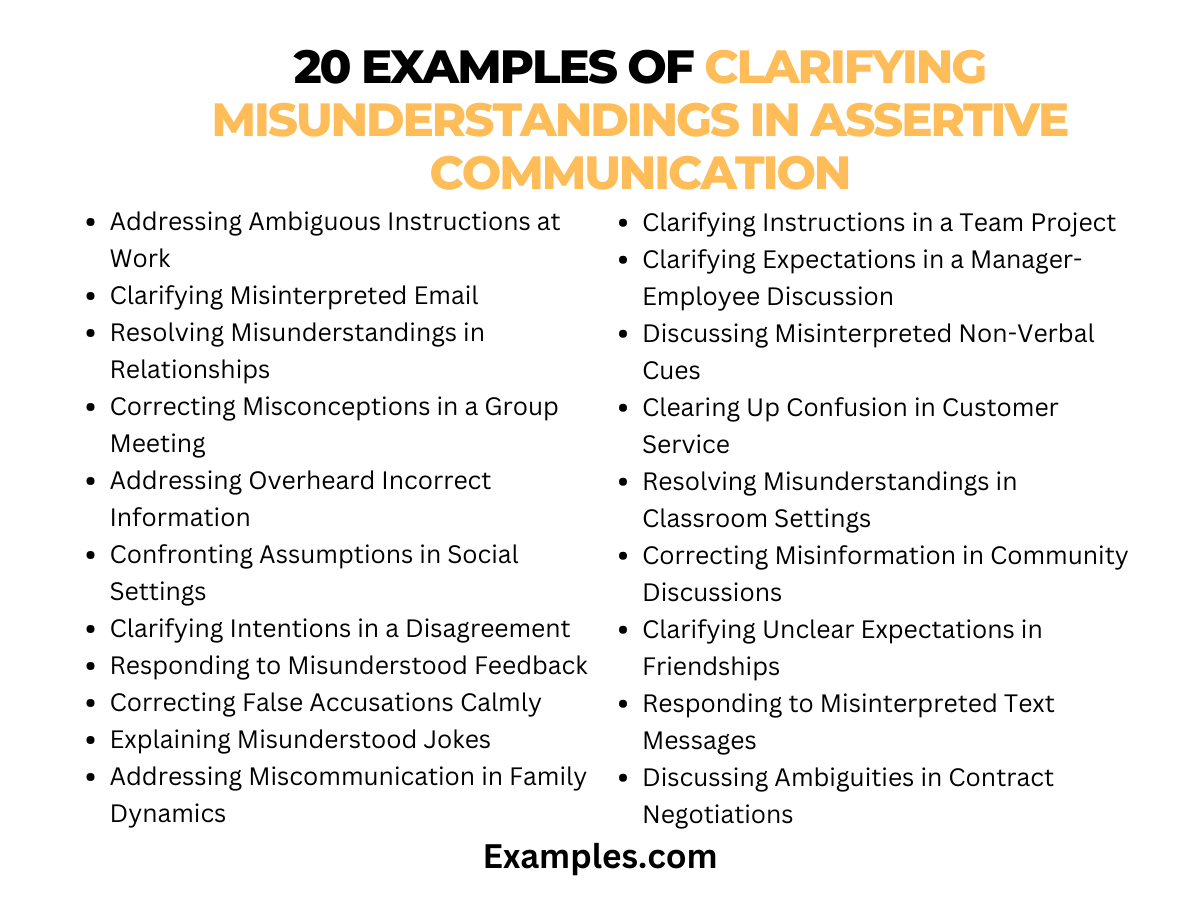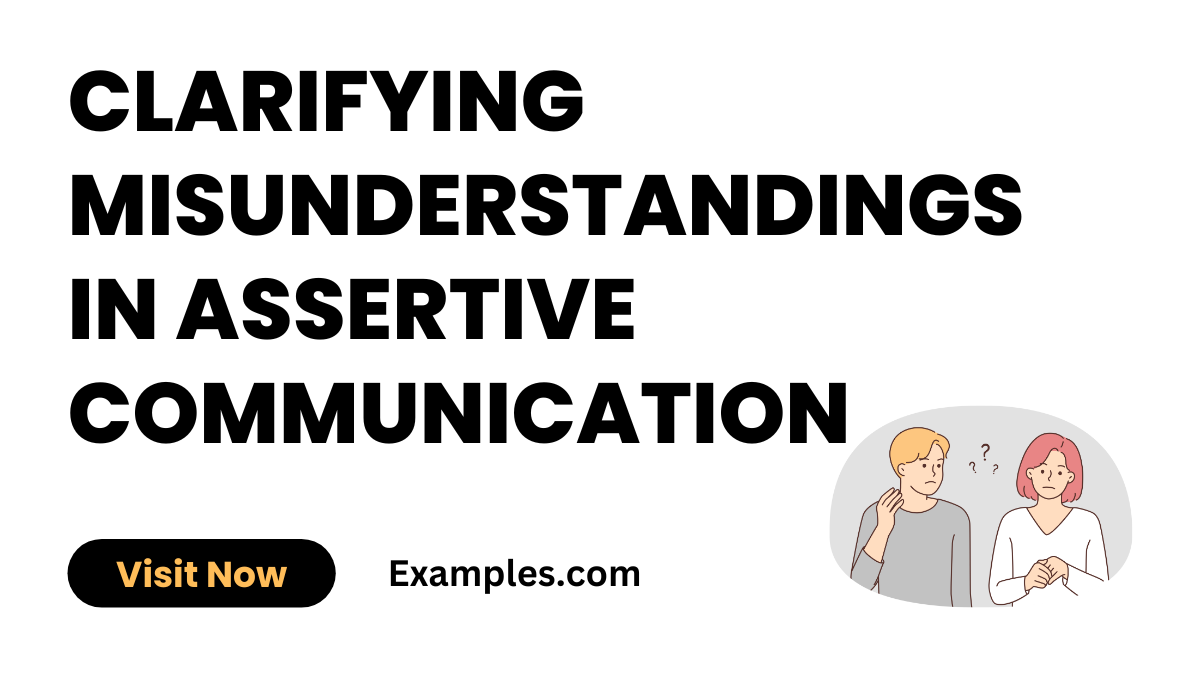19+ Clarifying Misunderstandings in Assertive Communication Examples
Navigating the complexities of communication, this guide delves into the nuances of clarifying misunderstandings through assertive communication. It’s a comprehensive resource, enriched with practical oral communication examples, designed to enhance your interactions both personally and professionally. Here, you’ll learn how to articulate your thoughts clearly and respectfully, ensuring your message is understood as intended. This guide is invaluable for anyone looking to improve their communication skills and resolve conflicts with confidence and empathy.
20 Examples of Clarifying Misunderstandings in Assertive Communication
Misunderstandings are a common part of human interaction, but addressing them assertively can enhance clarity and mutual understanding. This article delves into 20 distinctive examples of clarifying misunderstandings using assertive communication techniques. These scenarios demonstrate how effective communication, rooted in empathy, respect, and clarity, can resolve confusion and build stronger relationships in various aspects of life, from personal interactions to professional settings.

- Addressing Ambiguous Instructions at Work: “I want to ensure I understand your instructions correctly. Could you clarify what you mean by ‘urgent’ in this context?”
- Clarifying Misinterpreted Email: “It seems my email may have been misinterpreted. I intended to convey support for your idea, not criticism.”
- Resolving Misunderstandings in Relationships: “When you said that, I felt hurt. Can we talk about what you really meant?”
- Correcting Misconceptions in a Group Meeting: “I believe there’s a misconception about my earlier point. Let me rephrase it for better understanding.”
- Addressing Overheard Incorrect Information: “I overheard you mentioning my role in the project, and I think there’s been a misunderstanding. Here’s what actually happened.”
- Confronting Assumptions in Social Settings: “I sense that you’ve made an assumption about my opinion. Can we discuss this openly?”
- Clarifying Intentions in a Disagreement: “I want to clarify my intention wasn’t to argue, but to express a different perspective.”
- Responding to Misunderstood Feedback: “Your feedback seemed a bit unclear to me. Could you explain what specific areas I need to improve?”
- Correcting False Accusations Calmly: “I understand you’re upset, but the accusation isn’t accurate. Let’s go over the facts together.”
- Explaining Misunderstood Jokes: “I realize my joke didn’t land as intended. I apologize if it came off the wrong way.”
- Clarifying Instructions in a Team Project: “To avoid any confusion, let’s go over the project steps one more time for clarity.”
- Addressing Miscommunication in Family Dynamics: “I think there’s been a misunderstanding about my comment at dinner. Let me explain what I meant.”
- Clarifying Expectations in a Manager-Employee Discussion: “Could you clarify the expectations for this role? I want to ensure I’m on the right track.”
- Discussing Misinterpreted Non-Verbal Cues: “I noticed you seemed upset by my reaction. I want to clarify what my body language was conveying.”
- Clearing Up Confusion in Customer Service: “I’m not sure we’re on the same page about my issue. Let me explain it again.”
- Resolving Misunderstandings in Classroom Settings: “I think there’s a misunderstanding about my question. What I meant to ask was…”
- Correcting Misinformation in Community Discussions: “There seems to be some misinformation circulating. Here are the correct details.”
- Clarifying Unclear Expectations in Friendships: “I felt confused by what you expect from our plans. Can we discuss this more?”
- Responding to Misinterpreted Text Messages: “My text might have come across differently than intended. Let’s talk it out in person.”
- Discussing Ambiguities in Contract Negotiations: “Some terms in the contract are ambiguous. Can we clarify these points to avoid future confusion?”
Navigating and Resolving Misunderstandings with Assertive Communication Techniques
Unlock the secrets to effective conflict resolution with our guide on Navigating and Resolving Misunderstandings with Assertive Communication Techniques. Learn to approach misunderstandings with confidence and clarity. This guide provides insightful strategies, enhancing your assertive communication skills to foster understanding and respect in all your interactions.
- Handling Vague Feedback from a Supervisor: “I appreciate your feedback, but could you provide more specific examples so I can understand and improve?”
- Clarifying Project Goals in Team Meetings: “Let’s ensure we’re aligned on our project goals. Can we go over them once more for clarity?”
- Discussing Misunderstood Work Deadlines: “I understood the deadline as next Friday. Can we confirm to ensure we’re on the same track?”
- Interpreting Ambiguous Client Requests: “Your request seems a bit broad. Could you specify so we can meet your expectations accurately?”
- Addressing Mixed Messages in Relationships: “I’m getting mixed signals from our conversation. Can we clarify to avoid further confusion?”
- Responding to Unclear Instructions in Group Tasks: “To avoid any mistakes, could you clarify these instructions for the whole group?”
- Confronting Conflicting Advice from Colleagues: “I received differing advice on this matter. Can we discuss to find a common ground?”
- Clarifying Misunderstood Sarcasm in Social Settings: “I sense your comment was sarcastic, but I want to ensure I’m not misinterpreting it.”
- Addressing Miscommunication in Remote Work Settings: “Since we’re working remotely, let’s clarify these points to ensure seamless collaboration.”
- Responding to Contradictory Information in Discussions: “There seems to be some contradictory information here. Let’s go through it again for clarity.”
Effective Strategies for Clearing Up Confusion in Assertive Communication
Discover Effective Strategies for Clearing Up Confusion in Assertive Communication with our expertly crafted guide. It’s tailored to empower you with techniques and assertive communication skills to navigate through confusing conversations with ease, ensuring your messages are conveyed clearly and effectively.

- Clarifying Terms in Academic Discussions: “I’m not sure I understand this term as you do. Can we define it together?”
- Handling Misinterpretations in Creative Collaborations: “I think my idea was misinterpreted. Let me explain it again with an example.”
- Correcting Misunderstood Intent in Text Messages: “My text may have come across differently. Let me rephrase to avoid any misunderstanding.”
- Addressing Ambiguity in Customer Queries: “Your question seems a bit ambiguous. Could you elaborate so I can assist better?”
- Resolving Misunderstandings in Family Decisions: “There seems to be a misunderstanding about our decision. Let’s discuss it again for clarity.”
- Discussing Unclear Health Advice: “This health advice seems unclear to me. Can we go over it again for my understanding?”
- Interpreting Vague Responses in Interviews: “Your response seems a bit vague. Could you elaborate for more clarity?”
- Clarifying Misconceptions in Community Meetings: “There’s a common misconception here. Let’s clear it up for everyone’s understanding.”
- Responding to Ambiguous Feedback in Performance Reviews: “Your feedback is a bit ambiguous. Could you provide more specific details?”
- Addressing Unclear Expectations in Relationship Talks: “I feel the expectations in our conversation aren’t clear. Let’s discuss them openly.”
How Do You Clarify Misunderstandings in Assertive Communication?
Clarifying misunderstandings in assertive communication is crucial for maintaining healthy, effective interactions. Assertive communication, characterized by clarity, respect, and confidence, offers a structured approach to resolving confusion and ensuring mutual understanding. Here’s how to effectively clarify misunderstandings assertively:
- Active Listening: Begin by listening intently to understand the other person’s perspective fully. Active listening in assertive communication involves paying attention to both the words and the non-verbal cues.
- Use ‘I’ Statements: When clarifying, use ‘I’ statements to express your understanding or confusion. This reduces the likelihood of the other person becoming defensive. For instance, “I’m unclear about what you meant when you said…”
- Ask Open-Ended Questions: Encourage a clear explanation by asking open-ended questions. This invites elaboration and helps in gaining a complete understanding.
- Summarize and Repeat Back: To ensure you’ve understood correctly, summarize what was said and repeat it back. This step, known as reflective listening, is a key component of empathetic listening in assertive communication.
- Acknowledge Any Confusion: Be honest about any confusion or misunderstanding from your end. This showcases honesty and openness in communication.
- Maintain a Respectful Tone: Ensure your tone remains respectful and calm throughout the conversation. Respectful tone and emotional control are vital in assertive communication.
- Seek Mutual Understanding: Aim for a mutual understanding rather than just putting your point across. This collaborative approach falls under solution-oriented assertive communication.
- Offer Your Perspective Clearly: Share your viewpoint or interpretation clearly and concisely, ensuring clear expression in your communication.
By applying these techniques, misunderstandings can be clarified effectively, paving the way for a more constructive and harmonious interaction.
What Are the Common Causes of Misunderstandings in Communication, and How Can Assertiveness Help?
Misunderstandings in communication are common and can arise due to various factors. Recognizing these causes and utilizing assertive communication can significantly help in preventing and resolving such issues:
- Ambiguity in Communication: Vague or ambiguous language often leads to misunderstandings. Assertiveness aids in seeking and providing clarity with direct communication.
- Cultural and Language Differences: Cultural nuances and language barriers can cause misinterpretations. Assertiveness, particularly empathy and respectful tone, helps navigate these differences.
- Non-Verbal Miscommunication: Body language or tone of voice can convey unintended messages. Non-verbal assertiveness ensures that your body language aligns with your words.
- Personal Biases and Assumptions: Personal biases or assumptions can cloud understanding. Assertive communication advocates for open and honest expression, reducing the impact of personal biases.
- Emotional Responses: Emotions can distort both the delivery and reception of messages. Assertive communication, with its focus on emotional control, helps in managing emotional responses effectively.
- Lack of Active Listening: Failing to listen actively leads to partial understanding. Active listening is a core aspect of assertive communication, ensuring full comprehension.
- Overloaded Information: Too much information at once can be overwhelming. Assertive communication encourages clear expression and setting boundaries in information sharing.
In conclusion, assertiveness, with its emphasis on clear, respectful, and empathetic communication, can significantly mitigate the common causes of misunderstandings, leading to more effective and harmonious interactions.



